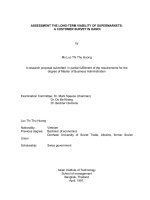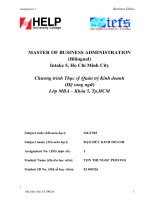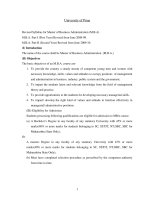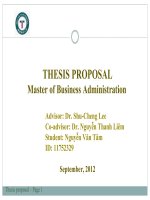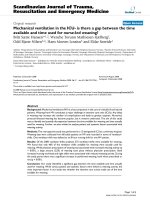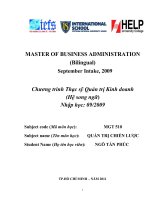Master of Business Administration: Is there a relationship between applying lessons learned and project success?
Bạn đang xem bản rút gọn của tài liệu. Xem và tải ngay bản đầy đủ của tài liệu tại đây (2.02 MB, 172 trang )
DUBLIN BUSINESS SCHOOL
(DBS)
Is there a relationship between applying
lessons learned and project success?
A mixed method study of project manager’s in Ireland.
By John Connolly
Student registration number: 1748704
22nd August 2014
A Dissertation Presented in Partial Fulfilment
of the Requirement for the Master of
Business Administration in Project Management
Awarded by
Liverpool John Moore‟s University and the Dublin Business School.
Under the Supervision of:
Mr. Patrick Mongey.
“Is there a relationship between applying lessons learned and Project Success”
Table of contents:
Table of contents: ............................................................................................................... 2
List of abbreviations: .......................................................................................................... 7
List of figures...................................................................................................................... 7
List of tables ....................................................................................................................... 9
Declaration........................................................................................................................ 11
Acknowledgments ............................................................................................................ 12
Abstract ............................................................................................................................. 13
Chapter 1 - Introduction ........................................................................................................... 14
1.1 Research background and rationale ............................................................................ 14
1.2 Research area: ............................................................................................................. 17
1.3 Research objectives: ................................................................................................... 17
1.4 Research questions: .................................................................................................... 18
1.4 Research hypotheses: .................................................................................................. 19
1.5 Research suitability: ................................................................................................... 20
1.6 Recipient of research: ................................................................................................. 20
1.7 Research limitations ................................................................................................... 21
1.8 Benefits of this research: ............................................................................................ 22
1.9 Organisation of dissertation ........................................................................................ 23
Chapter 2 - Literary review ...................................................................................................... 24
2.1 Introduction to the literature review ........................................................................... 24
Page 2
“Is there a relationship between applying lessons learned and Project Success”
2.2 Project success: ........................................................................................................... 24
2.3 Project management methodology ............................................................................. 26
2.4 Project knowledge management: ................................................................................ 29
2.5 Lesson learned definition: .......................................................................................... 31
2.6 The value of using Lesson Learned: ........................................................................... 33
2.7 Impact of lessons learned on project success ............................................................. 35
2.8 The lessons learned process ........................................................................................ 36
2.8.1 Collection of Lessons learned.................................................................................. 38
2.8.2 Sharing of Lesson learned ....................................................................................... 41
2.9. Barriers to Lessons learned........................................................................................ 43
2.10 Organisation culture: ................................................................................................ 45
Chapter 3 - Research Methodology ......................................................................................... 48
3.1 Introduction to methodology chapter: ........................................................................ 48
3.2 Research design .......................................................................................................... 48
3.3 Research methodology: .............................................................................................. 49
3.4 Research philosophy: Combination of positivism & interpretation. .......................... 51
3.5 Methodology approach: Deductive: ........................................................................... 53
3.6 Research strategy: explanatory – Survey: Questionnaire & Interviews ..................... 55
3.7 Research choice: Multi method .................................................................................. 57
3.8 Time horizon: Cross sectional .................................................................................... 61
3.9 Data collection and analysis ....................................................................................... 62
Page 3
“Is there a relationship between applying lessons learned and Project Success”
3.10 Population & sample ................................................................................................ 62
3.11 Evaluation: Data collection, editing & coding ......................................................... 63
3.12 Quality Standards ..................................................................................................... 68
3.13 Research ethics ......................................................................................................... 70
3.14 Assumptions to research: .......................................................................................... 71
Chapter 4 - Data analysis and findings .................................................................................... 72
4.1 Overview .................................................................................................................... 72
4.2 Findings from quantitative analysis: Questionnaires. ................................................. 73
Question 1: ........................................................................................................................ 73
Question 2: ........................................................................................................................ 73
Question 3: ........................................................................................................................ 74
Question 4: ........................................................................................................................ 75
Question 5: ........................................................................................................................ 76
Question 6: ........................................................................................................................ 77
Question 7: ........................................................................................................................ 78
Question 8: ........................................................................................................................ 79
Question 9: ........................................................................................................................ 80
Question 10: ...................................................................................................................... 81
Question 11: ...................................................................................................................... 82
Question 12: ...................................................................................................................... 83
Question 13: ...................................................................................................................... 84
Page 4
“Is there a relationship between applying lessons learned and Project Success”
Question 14: ...................................................................................................................... 85
Question 15: ...................................................................................................................... 85
Question 16: ...................................................................................................................... 86
Question 17: ...................................................................................................................... 87
Question 18: ...................................................................................................................... 88
Question 19: ...................................................................................................................... 89
Question 20: ...................................................................................................................... 90
Question 21: ...................................................................................................................... 91
Question 22: ...................................................................................................................... 92
Question 23: ...................................................................................................................... 93
Question 24: ...................................................................................................................... 94
Question 25: ...................................................................................................................... 95
Question 26: ...................................................................................................................... 96
Question 27: ...................................................................................................................... 97
Question 28: ...................................................................................................................... 98
Question 29: ...................................................................................................................... 99
4.3 Findings from qualitative analysis: Interviews ......................................................... 100
Chapter 5 – Conclusions ........................................................................................................ 105
Chapter 6 - Recommendations ............................................................................................... 111
Future research: .............................................................................................................. 113
Chapter 7 - Self-reflective on own learnings and performance ............................................. 114
Page 5
“Is there a relationship between applying lessons learned and Project Success”
7.1 Introduction .............................................................................................................. 114
7.2 Learning styles .......................................................................................................... 114
7.3 Reflection on the dissertation writing the process: ................................................... 117
7.4 Reflection on sources................................................................................................ 117
7.5 Reflection on dissertation formulation ..................................................................... 118
7.6 Self-assessment of learning and skills acquisition and future skills development. .. 118
7.7 Reflective conclusions .............................................................................................. 120
7.8 Lesson learned during this process. .......................................................................... 121
Chapter 8 - References ........................................................................................................... 123
Chapter 9 - Appendix ............................................................................................................. 137
Appendix 1: Research Plan............................................................................................. 137
Appendix 2: Frequency Charts ....................................................................................... 139
Appendix 3: Cover letter for Questionnaire ................................................................... 158
Appendix 4: Confidentiality agreement ......................................................................... 159
Appendix 5: Quantitative Questionnaire ........................................................................ 160
Appendix 6: Interview Questions ................................................................................... 165
Appendix 7: Interviewee details ..................................................................................... 166
Appendix 8: Cost incurred during research: ................................................................... 169
Appendix 9: Researcher‟s SWOT analysis .................................................................... 170
Appendix 10: Steps in conducting a social survey ......................................................... 171
Page 6
“Is there a relationship between applying lessons learned and Project Success”
List of abbreviations:
KM
Knowledge Management
LL
Lessons Learned
PM
Project Manager
PMs
Project Managers
PMI
Project Management Institute
PPR
Post Project Reviews
List of figures
Figure 1: New approach to project management criteria. ........................................................ 26
Figure 2: Categories of KM Approaches ................................................................................. 31
Figure 3: The Organisational learning curve for improved performance over a series of repeat
activities or projects following learning. Adapted from Nick Milton (2010 p.9). ................... 34
Figure 4: Organisational Learning curves showing how learning can be accelerated. Adapted
from Nick Milton (2010 p.10). ................................................................................................ 34
Figure 5: A generic LL process ............................................................................................... 36
Figure 6: The „Research Onion‟ .............................................................................................. 49
Figure 7: Diagram of the researchers methodology based on Saunders‟s 2012 theory. .......... 50
Figure 8: The process of deduction. ......................................................................................... 54
Figure 9: Methodological choices ............................................................................................ 58
Figure 10: How to combine Qualitative and Quantitative Research. ...................................... 67
Figure 11: Bar Chart showing industry distribution of the sample. ......................................... 74
Figure 12: Bar Chart showing the project management experience of the sample. ................ 75
Figure 13: Bar Chart showing clarifying definition of „project success‟ for study. ................ 76
Figure 14: Bar Chart showing the frequency a LL report is accessed. .................................... 77
Figure 15: Bar Chart showing the respondents perception on the benefits of LL. .................. 78
Page 7
“Is there a relationship between applying lessons learned and Project Success”
Figure 16: Bar Chart showing respondents experience of LL affecting project success. ........ 79
Figure 17: Bar Chart showing the chances of project success if developing and implementing
a LL report. .............................................................................................................................. 80
Figure 18: Bar Chart showing respondents views on the sharing of LL and project success. . 81
Figure 19: Bar Chart showing views on the avoidance of mistakes by using LL. .................. 82
Figure 20: Bar Chart showing views on the contribution to mistakes by not using LL. ......... 83
Figure 21: Bar Chart showing areas affect most by using an LL report .................................. 84
Figure 22: Bar Chart showing the relationship between projects factors and LL. .................. 85
Figure 23: Bar Chart showing the relationship between procedural factors and LL. .............. 86
Figure 24: Bar Chart showing the relationship between people factors and LL. .................... 86
Figure 25: Bar Chart showing the tools/methods used to capture and record LL. .................. 87
Figure 26: Bar Chart showing the methods/tools used to access LL. ...................................... 88
Figure 27: Bar Chart showing method used to record/capture LL affects their future use. .... 89
Figure 28: Bar Chart showing the factors that affect LL being shared. ................................... 90
Figure 29: Bar Chart showing the factors that may promote the sharing of LL. ..................... 91
Figure 30: Bar Chart showing views on are people the drivers of LL. .................................... 92
Figure 31: Bar Chart showing how likely it is if organisations perform PPRs........................ 93
Figure 32: Bar Chart showing views on performing a mandatory PPR and project success... 94
Figure 33: Bar Chart showing views on if the use of LL had to be proved. ............................ 95
Figure 34: Bar Chart showing views on installing LL into best practices. .............................. 96
Figure 35: Bar Chart showing if LL should be improved in their organisation. ..................... 97
Figure 36: Bar Chart showing whether training would improve the use of LL. ...................... 98
Figure 37: Bar Chart showing responses to improving organisations learning culture. .......... 99
Figure 38: Kolb‟s Learning Cycle ......................................................................................... 115
Page 8
“Is there a relationship between applying lessons learned and Project Success”
List of tables
Table 1: Pros and cons of integrated versus post project methods for collecting LL. ............. 40
Table 2: Fundamental differences between quantitative and qualitative research strategies .. 60
Table 3: Frequency Table Gender profile of Respondents ...................................................... 73
Table 4: Frequency Table for age profile of Respondents ....................................................... 73
Table 5: Frequency Table Question 3 .................................................................................... 139
Table 6: Frequency Table Question 4 .................................................................................... 139
Table 7: Frequency Table Question 5 .................................................................................... 140
Table 8: Frequency Table Question 6 .................................................................................... 140
Table 9: Frequency Table Question 7 .................................................................................... 140
Table 10: Frequency Table Question 8 .................................................................................. 141
Table 11: Frequency Table Question 9 .................................................................................. 141
Table 12: Frequency Table Question 10 ................................................................................ 142
Table 13: Frequency Table Question 11 ................................................................................ 142
Table 14: Frequency Table Question 12 ................................................................................ 143
Table 15: Frequency Table Question 13 ................................................................................ 144
Table 16: Frequency Table Question 14 ................................................................................ 145
Table 17: Frequency Table Question 15 ................................................................................ 146
Table 18: Frequency Table Question 16 ................................................................................ 147
Table 19: Frequency Table Question 17 ................................................................................ 148
Table 20: Frequency Table Question 18 ................................................................................ 149
Page 9
“Is there a relationship between applying lessons learned and Project Success”
Table 21: Frequency Table Question 19 ................................................................................ 150
Table 22: Frequency Table Question 20 ................................................................................ 151
Table 23: Frequency Table Question 21 ................................................................................ 153
Table 24: Frequency Table Question 22 ................................................................................ 154
Table 25: Frequency Table Question 23 ................................................................................ 154
Table 26: Frequency Table Question 24 ................................................................................ 155
Table 27: Frequency Table Question 25 ................................................................................ 155
Table 28: Frequency Table Question 26 ................................................................................ 156
Table 29: Frequency Table Question 27 ................................................................................ 156
Table 30: Frequency Table Question 28 ................................................................................ 156
Table 31: Frequency Table Question 29 ................................................................................ 157
Page
10
“Is there a relationship between applying lessons learned and Project Success”
Declaration
I, John Connolly, declare that this research report is my own, unaided work, except as
indicated in the acknowledgments, the text and the references.
This report is being submitted in partial fulfilment of the requirements for the degree of
„Master of Business Administration Project Management‟ at Dublin Business School, Dublin.
It has not been submitted before, in whole, or in part for any degree or examination at any
other institution.
John Connolly
Signed ……….………………………………… on the day of 22/08/2014
Page
11
“Is there a relationship between applying lessons learned and Project Success”
Acknowledgments
I am very grateful to my supervisor Mr. Patrick Mongey, lecturer within the Management
department at the Dublin Business School. He guided me in writing this paper and was very
supportive in answering any queries I had. His experience and knowledge contributed to my
continuous progress with this dissertation.
I would also like to thank Mr. Paul Taffe and Mr. Patrick O‟ Callaghan who were my Project
Management lecturers at Dublin Business School; they guided me in my search for a research
title and also inspired me through their lectures and passion of the project management
subject area.
I would also like to thank all of the lecturing and library staff at Dublin Business School for
their constant support and professionalism throughout all the stages of the MBA program.
I owe a special thanks to Gwen for her unconditional support and patience throughout this
process. Her ability to be supporting and encouraging was crucial in my completion of this
program especially when procrastination took over.
A great gratitude is due to my parents, my brother and sister whose encouragement in all of
my projects throughout my life has been an endless source of support for me.
I thank each participant for sharing with me their valuable knowledge and project
management experience. With them this research would not have been possible.
Lastly I would like to thank all my friends, especially my housemates who encouraged me to
finish the MBA program.
Page
12
“Is there a relationship between applying lessons learned and Project Success”
Abstract
The aim of this dissertation is to discover if there is relationship between applying Lessons
Learned (LL) and project success in the context of project management. In addition it will
investigate the factors affecting the collection and dissemination of LL to determine what role
these play in inhibiting the successful use of LL. This paper was built around Project
managers (PMs) in Ireland. From this research recommendations are made to improve the use
of LL and to avoid the barriers that impede the successful implementation of LL. There is
very little research done on the direct impact of LL on project success particularly Ireland.
The dissertation includes a mixed method approach to generate the data. The mixed method
approach combines quantitative and qualitative research. The quantitative research was
compiled by the use of an electronic questionnaire. The qualitative research consisted of face
to face interviews. This approach has given a more complete and comprehensive
understanding of the research problem that either approach alone.
The research findings correlate with both the primary and secondary sources of data to
establish that there is a relationship between applying lessons learned and project success.
The findings strongly suggest that the approach to how lessons learned are collected and
disseminated needs to be modified to increase the benefits from applying lessons learned.
Page
13
“Is there a relationship between applying lessons learned and Project Success”
Chapter 1 - Introduction
This paper starts with an introductory chapter. An introduction is the first passage and sets the
stage for the entire project (Creswell 2014 p.107). The researcher‟s goal is to introduce the
reader to the background of the dissertation, clarify the significance of the research problem
and explain the benefits and importance of this study.
1.1 Research background and rationale
In the current climate Project managers (PMs) have to reach project goals without an
appropriate budget, a rational timetable, or a competent project team etc. To add to this the
environment is unpredictable and unreliable. To achieve project success PMs must be armed
with dependable contemporary knowledge and innovative practice experiences (Neverauskas
et al 2013).
To stay competitive, organisations today have been moving from operations and business as
usual to project management as part of their competitive strategy. The ability to execute
projects effectively will drive the realisation of the proposed benefits and the achievement of
business objectives (PWC, 2012). Organisations are becoming more project focused with
defined, even mature processes for initiating, planning, monitoring, executing and controlling
activities. The important question being asked is “are they learning from project to project”
(Rowe, 2008).
LL has been mentioned as one of the most important and value adding pieces of the project
management lifecycle but it has been stated that it is often the most ignored part of finishing a
project (Walker, 2008). Knowledge creation and knowledge sharing are important factors in a
company‟s ability to survive and compete in today‟s knowledge based economy (HallAndersen and Broberg, 2014).
Page
14
“Is there a relationship between applying lessons learned and Project Success”
It appears projects are not being successfully executed in the current environment. On
average large IT projects run 45% percent over budget and 7% over time while delivering
56% less value than predicted. When comparing budgets, schedules, and predicted
performance benefits with actual costs and results found that these IT projects in total had a
cost overrun of $66 billion (Bloch et al., 2012). In a project management institute (PMI)
study which is consistent with other studies, shows that less than two-thirds of projects meet
their goals and business intent (success rates have been falling since 2008), and about 17
percent fail outright (PMI, 2013). It appears many PMs are not using recommended good
practices and face uncertain issues because of the lack of reliable information (Neverauskas
et al 2013).
Knowledge management (KM) relating to temporary organisations is an increasingly even
decisive competitive factor (Hanisch, 2009). Since (Drucker, 1999) argued that knowledge
had replaced tangible assets as the principle driver of economic growth KM has generated
widespread interest. There are significant figures relating to ineffective KM research. It is
estimated that US Fortune 500 companies lose at least $31.5 billion a year by failing to share
knowledge (Babcock, 2004, cited in Massingham and Massingham, 2014). Only 40% of
companies surveyed say their companies are good or excellent at feeding back lessons from
successful implementation into strategic planning and just 33% when it comes to
unsuccessful ones. 33% have no method for doing so (PMI, 2013).
A focus on KM ensures that there are practices in place to transfer the insights and
experiences of a team working on projects with other teams throughout the organisation
facing similar challenges or opportunities. 65% high performing PMOs regularly
communicate LL and 59% consider the impact of collaboration on projects. This compares to
Page
15
“Is there a relationship between applying lessons learned and Project Success”
low performing companies with only 49% and 40% of respectively (PMI, Nov, 2013). This
indicates that higher performing PMOs use LL.
The area of LL is important for many reasons. Firstly, it can improve results at an operational
level resulting in an improvement in the profits. Secondly as mentioned earlier knowledge
based assets are a source of competitive advantage. Subsequently Learning lessons from
previous project experiences helps to achieve economies of learning but also, these practices
can contribute to a company‟s competitive advantage, due to knowledge based practices
uniqueness and difficulty in replicating and become organisationally embedded over time
(Jugdev, 2012).
Academic publications on the role of using KM and how it can be used in the management of
projects to improve success are very rare (Lierne and Ribiere, 2008). The project
management community are aware that they are poor at LL and they do not know why this is
or how they can improve their current stance (Rhodes and Dawson, 2013).
This dissertation investigates if KM specifically the use of LL can demonstrate a relationship
between their implementation and future project success. While also considering the barriers
that hamper the effective use of LL on current/new projects. By not utilising LL are PMs in
Ireland missing a big opportunity to enhance the service they provide to their clients and to
improve as PMs?
Page
16
“Is there a relationship between applying lessons learned and Project Success”
1.2 Research area:
Is there a relationship between the use of LL and project success?
How do PMs in Ireland record/access LL and what factors affect their use?
How are LL shared by PMs in Ireland and what factors affect this process?
What are the cultural implications experienced by PMs in Ireland in relation to the use of LL?
1.3 Research objectives:
Research objectives are clear, specific statements that identify what the researcher wishes to
accomplish as a result of doing the research (Saunders et al. 2012, p680). Based on the
extensive literature review the main objectives for this research are:
1. To examine if the use of LL has a relationship with new or existing project success.
2. To discover the methods which LL are recorded/accessed, and access what factors
impacts their use on current and future projects.
3. To discover how LL are being shared and what factors impacts their use on current and
future projects.
4. To determine if the organisational culture in Ireland either inhibits or promotes the use of
LL in current and future projects.
Page
17
“Is there a relationship between applying lessons learned and Project Success”
1.4 Research questions:
1. Does the use of LL by PMs in Ireland affect new and existing project success?
Rationale: LL is becoming an increasingly important topic for organisations, but many
struggle with the collection and dissemination of lessons, consequently making them poor at
achieving any benefits from LL (Rhodes and Dawson, 2013). The literature would suggest
that LL is important to project success. The aim is to discover if PMs in Ireland have
experienced benefits from using LL.
2. What methods do PMs in Ireland use to record/access LL and what factors inhibit this
process?
Rationale: Post project reviews (PPRs) appear to be the most popular method used by PMs
around the world and play a fundamental role in promoting organisational learning (Carrillo,
2011). Their effectiveness has widely been questioned (Milton, 2010). Research has also
highlighted the limited use of KM systems (Carrillo et al., 2013).The aim of this question is
to highlight what methods PMs in Ireland use to capture/access LL and to discover what
factors impact this process. By researching this area it may highlight issues regarding the use
of LL on future projects.
3. How are LL shared by PMs in Ireland and what factors inhibits this process?
Rationale: For the sharing knowledge to occur and contribute, certain factors have to be in
place so that an individual shares his knowledge with others (Obrenovic and Qin, 2014).
Milton, (2010) found that organisations identified and capture lessons but the lessons were
not shared to deliver intended changes in organisations behaviour, process, best practices or
standards. Key factors affecting the sharing of LL highlighted in recent studies include top
management support, values, incentives and social capital (Obrenovic and Qin, 2014). The
Page
18
“Is there a relationship between applying lessons learned and Project Success”
aim here is to highlight how PMs in Ireland share LL and to discover what factors impact this
process. By researching this area it may highlight issues regarding the use of LL on future
projects.
4. Does the organisational culture experienced by PMs in Ireland affect the use of LL in
current/future projects?
Rationale: Organisations with a positive culture, encouraging the values of individual
learning by sharing processes that contribute to group or organisational learning, can lead to
organisational success (Rebel and Gomes, 2011). A positive culture alone may be inadequate
to assist knowledge sharing and more research is needed to understand how a knowledge
sharing culture can be promoted (Wang and Noe, 2010). The aim for this question is to
discover if PMs in Ireland experience a learning culture promoting to the use of LL. By
researching this area it may highlight issues regarding the use of LL on future projects.
1.4 Research hypotheses:
H1: There is a positive relationship between the use of LL by PMs in Ireland and
current/future project success.
H2: The most commonly used method to record and access a LL is a PPR but it is not fit for
purpose.
H3: The lack of clear guidelines regarding LL is the main reason for LL not being shared.
H4: There is a positive relationship between being in an organisation with a learning culture
and the use of LL experienced by PMs in Ireland.
Page
19
“Is there a relationship between applying lessons learned and Project Success”
1.5 Research suitability:
The researcher holds a degree in Landscape architecture from University College Dublin. He
has successfully completed all the relevant modules in the MBA Project Management
program at Dublin Business School. The use of all the information gained throughout the
modules, especially the two project management modules; project management tools and
techniques and project management planning and control, has supported this research project.
The researcher has knowledge and enthusiasm towards project management especially the
areas of KM and in particular the use of LL for continuous improvement in project
management. He is self – assured, dedicated and suitable to undertake this research project.
1.6 Recipient of research:
This research project is intended to perform a detailed investigation to understand PMs in
Ireland understanding of the relationship of LL and its contribution to project success. Many
of the respondents, of the self-administered web based surveys and face to face interviews,
have shown an interest in the results of this research project. A copy of the results of this
survey will be available to any respondents who have requested the results.
This dissertation is submitted as part of the Masters in Business Administration Project
Management curriculum in Dublin Business School in association with Liverpool‟s John
Moore University. The primary recipient of this research project is Dublin Business School
and Liverpool‟s John Moore University staff and students, especially Mr. Patrick Mongey.
Page
20
“Is there a relationship between applying lessons learned and Project Success”
1.7 Research limitations
Although this study has revealed meaningful findings in the area of LL specially identifying
the relationship between LL and project success plus what affect the use of LL by PMs in
Ireland. First and foremost the research is conducted in Ireland.
Limitations may include access to information, availability of enough resources and time
management. In time management the ability to balance work and study may be difficult
especially during the summer as it is peak season in the researcher business. To overcome
this issue a study plan was created and followed with two evenings a week dedicated to the
dissertation. This increased closer to the hand in date.
To access primary data, the PMs were contacted and persuaded of the importance of the
research and how valued their response to the survey would be. As the researcher has had no
previous contact with PMs this may lead to disinterest towards the research and ultimately
unwillingness to participate in the surveys and interviews.
Another limitation maybe the availability of experts in editing and guidance at difficult times
could be minimal. Also as PMs are very busy, there is a risk that they will not have sufficient
time to complete the survey or meet for face to face interviews. If the PMs respond to the
survey their busy schedules might affect the quality of responses. To counteract this adequate
notice will be given to experts so as they have time to respond and offer their guidance.
Shortage of time, due to completing this mixed method research study part time proved a
challenge as the balance between working and research is a difficult balancing act. When
using a mixed method approach the research can face many limitations. First of all due to
time constraints a mixed method approach is time consuming as the researcher has to learn
multiple methods and mix each method effectively. A mixed method approach is costly as
Page
21
“Is there a relationship between applying lessons learned and Project Success”
arrangements have to be made to meet interviews. The limitations of each approach are
discussed further in the chapter 3.
Despite these limitations, this study has made a valuable contribution in extending the
literature in the area of knowledge management especially LL.
1.8 Benefits of this research:
The researcher hopes that the resulting research will illustrate to project management
professionals, organisations and project management students a greater appreciation of the
valuable contribution Lessons Learned can make, not only to increased project success but to
an organisation as a whole. It will also highlight the barriers that hamper the effective use of
LL on current/new projects.
.
Page
22
“Is there a relationship between applying lessons learned and Project Success”
1.9 Organisation of dissertation
The organisation of this dissertation is divided into nine separate chapters, each dealing with
a separate area of the study for this research project.
Chapter 1: is an introduction to the dissertation including several parts of the research
project including the research area, research objectives, research questions and research
hypothesis
Chapter 2: Is the literature review which contains the academic materials read and critiqued
by the researcher about this dissertation topic.
Chapter 3: Comprises of the research methodology. This section illuminates how and why
the researcher is going to carry out the research project in order to obtain answers to research
questions, determine the validity of the research hypothesis and meet the objectives of the
research objectives.
Chapter 4: Contains the data analysis and findings section. In this section the results and
findings of the data collected are recorded on paper
Chapter 5: Includes the conclusions, which provides the researchers conclusions to the
research project and research area.
Chapter 6: Precludes are the recommendations, which provides the recommendations the
researcher has made in relation to the topic.
Chapter 7: Deals with the researcher‟s reflection about the experience in conducting this
research project at Dublin Business School.
Chapters 8 and 9: Contain the appendices and bibliography related to the research
undertaken for this project.
Page
23
“Is there a relationship between applying lessons learned and Project Success”
Chapter 2 - Literary review
2.1 Introduction to the literature review
Reviewing the Literature gives you a foundation on which your research is built. It helps the
researcher develop a good understanding and insight into relevant previous research and the
trends that have emerged. A critical literature review should be a constructively critical
analysis that develops a clear argument for what is known and unknown about the research
question (Saunders et al., 2012, p. 73).
The following chapter will first give a general insight into project success to illustrate to the
reader what exactly defines a successful project. From here the project management
methodologies approach to LL, the concept of LL and how it impacts on existing and new
projects including the barriers that affect its success will be discussed and analysed from the
existing literature. This will be done to provide a framework to be compared against the
primary data collected from project management professionals in Ireland.
There have been many articles published on KM, organisational learning and the barriers to
LL. However not many studies have focused on specifically the relation between LL and
project success. The expected result of the undertaken study is to add to the existing literature
by closing the gap and enlighten project management professionals regarding the increased
likelihood of project success by the use of LL. While also making PMs aware of the issues
concerning the processes involved in using LL on future projects.
2.2 Project success:
Organisations need successful projects to improve their performance. As the review of the
literature has illustrated there is no consistent interpretation of project success (Neverauskas
et al., 2013). The universally accepted definition of a project according to the Project
Page
24
“Is there a relationship between applying lessons learned and Project Success”
Management Institute (PMI) is “A project is a temporary endeavour undertaken to create a
unique product, service or result (PMI 2013, p. 3). PMs frequently have to reach project goals
without having an appropriate budget, rational timetable, competent project team. To add to
this, the environment is unpredictable and unreliable, so PMs must be equipped with
dependable contemporary knowledge and advanced practice experiences. These combined
will contribute to project success (Neverauskas et al., 2013).
In early literature project success was viewed narrowly as the accomplishment of certain
objectives. These included specification, time and budget but the project context has now
shifted. Now it is recognised that there is a need for a broader set of outcome measures
(Andersen et al., 2006). One of the broader outcome measures for temporary organisations is
KM which is now becoming an increasingly important and even a decisive competitive factor
(Hanisch, 2009). Knowledge creation and dissemination are now included by project owners
as factors that determine if the project is successful or not (Fusco, 1997).
In determining project success it is important to know what factors are critical to project
management success, an individual project and what leads to consistently successful projects
(Neverauskas et al., 2013). To answer these there is need for a distinction between the
concepts „project management success‟ and „product success‟ (Van der Westhuizen &
Fitzgerald, 2005).
„Project management success‟ coincides with the traditional views of the successful
accomplishment of cost, time and quality objects but broadens to include the quality of the
project process or work. This extra objective is considered to be the responsibilities of project
management, hence if these objectives are met this is considered a „project management
success‟ (Munns and Bjeirmi, 1996). Whereas „product success‟ focuses on the projects final
product and its impact after it is completed, as in all the objectives are met, such as meeting
Page
25
